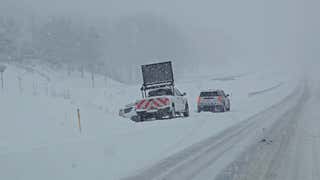
Sign up for the Morning Brief email newsletter to get weekday updates from Weather Now 24 and our meteorologists.
A winter storm swept quickly from the central U.S. to Ohio Valley and the East Coast in the days before Valentine's Day 2025,leaving behind a snowy and icy mess of commuting headaches for millions and damaging ice for some.
This storm was named Harlow by Weather Now 24 and was the third winter storm in the eastern half of the nation in about a week's time.
(MORE:Why Winter Storms Are Named)
How Much Snow,Ice
Harlow began Monday night,Feb. 10,with light snow and freezing rain from parts of Oklahoma and the Ozarks into the Ohio Valley and Appalachians.
Ice accumulations of one-tenth to one-quarter inch were observed in northwest Arkansas,southern Missouri and northeast Oklahoma near Tulsa.
The wintry mess than intensified in the Appalachians and spread through the mid-Atlantic and up parts of the Eastern Seaboard Tuesday into Tuesday night,before ending in most areas by early Wednesday morning,Feb. 12.
Harlow produced a swath of 6 to 12 inches of snow from southern West Virginia into the northern two-thirds of Virginia,the District of Columbia,the Delmarva Peninsula and extreme southern New Jersey. Peak amounts of 14 to 15 inches were reported near Iron Gate,Virginia,and near Meadow Bluff,West Virginia.

In the Washington,D.C. metro area,snowfall totals ranged from 3 to 9 inches,with the heaviest totals in the southern suburbs. Reagan National Airport's 6.4 inch total from Harlow pushed it above an average season's snowfall (13.8 inches) for the first time in six years.

Farther north,lighter accumulations from 1 to 3 inches were reported across southeast Pennsylvania into the New York City tri-state and extreme southern New England.
Harlow was a disruptive ice storm in parts of southern Virginia and far western north Carolina as far south as the South Carolina border.
Some areas picked up one-half to just under two-thirds of an inch of ice accumulation,which lead to some downed trees and branches. About 200,000 customers lost power in the storm,primarily in southern Virginia as far east as Richmond,but also into western North Carolina,according to poweroutage.us.








